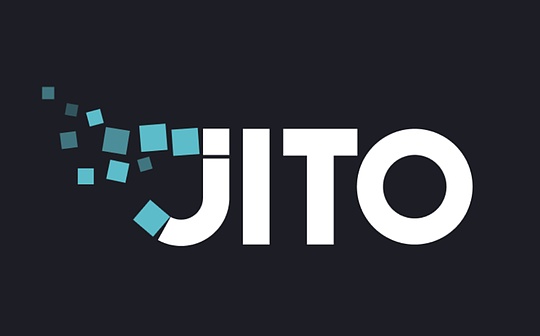
Author: David C, Bankless; Compilation: Deng Tong, Bitchain Vision
Solana’s staking remains one of the most active parts of the network.
Pledge, which means locking capital in exchange for network security, thus gaining benefits, is an important part of DeFi and one of the most powerful sectors in the on-chain economy.Staking requirements vary from chain to chain; Ethereum requires native staking of 32 ETH on personal nodes, or users can choose mobile staking providers such as Lido or Rocket Pool.On Solana, anyone can stake natively through its delegated proof of stake system by delegating to the verifier rather than running their own nodes.
The convenience of this pledge may explain the huge gap between Solana and Ethereum in total pledged assets and current pledged assets.Solana has $61 billion in staking capital, surpassing Ethereum but lags behind in liquid staking.Ethereum has 65% of its staked ETH in liquid form, while only 6.5% of Solana’s staked SOL is liquid staked tokens (LST), indicating that Solana has huge growth opportunities.
In this article, we will explore the current areas of SOL liquid staking, research key players, and protocols to innovate and cope with this opportunity.Let’s get started!
Solana’s top LST
Jito, Marinade Finance and Jupiter dominated Solana’s liquid staking, holding 80% of SOL in LST.Let’s take a look at how each agreement is unique and how they increase their share of staking.
Jito’s JitoSOL
Not only is JitoSOL the largest LST (holding 48% of the liquid staking SOL, worth $1.7 billion), Jito is also the largest agreement on Solana.
Jito is known for its massive airdrops, which allows users to stake SOLs and receive JitoSOLs for use in DeFi networks.
Jito’s standout features come from its unique approach to MEV, which brings better rewards to users while keeping the network healthy.Jito supports special validators that optimize block space and fairly include transactions, avoiding harmful strategies such as mezzanine attacks or preemptive transactions.So, this helps the MEV behave more positively, allowing JitoSOL holders to make about 15% more.
As the largest LST on the network, JitoSOL is deeply rooted in DeFi.It is a popular asset borrowed across protocols such as Solend, Drift and Marginfi and can be leveraged on Kamino for higher returns.These integrations create a liquid flywheel that positions JitoSOL as the most efficient, most efficient LST, increasing demand for the asset.Finally, Jito’s impact on Solana’s network is more than just increasing stake rewards.With StakeNet, a decentralized system for optimizing validators, Jito improves performance and distributes rewards fairly, making the network more efficient and safer for all participants.

Marinade Finance’s mSOL
Marinade Finance ranked second, accounting for 22% of LST’s total market share.
Marinade’s mSOL was launched in August 2021 with a feature similar to JitoSOL, and the staking rewards continue to appreciate over time.In July 2023, Marinade launched Marinade Native, allowing direct staking of SOL and rewards for each stage, avoiding the risk of smart contracts while retaining control over SOL.Additionally, Marinade’s protected staking rewards ensure that stakers do not lose their rewards due to verifier performance issues by requiring verifiers to provide margin.
Marinade was once the largest LST and was later taken away by Jito, but overall it remains the second largest deal on Solana.However, its TVL continues to churn, not losing share to Jito, but to Sanctum, a protocol for creating, starting and unifying LST liquidity.

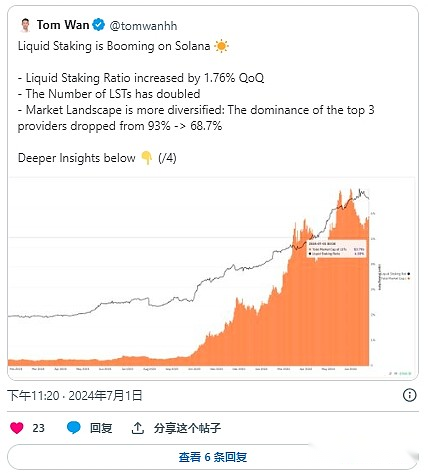
Jupiter’s JupSOL
Ranked third is JupSOL, whose 10% SOL is staked in LST launched by Jupiter and Sanctum.
Released in April, JupSOL quickly captured market share, offering an instant mobile version of SOL staked by Jupiter Verifier.In addition to pledge rewards and MEV rebates, JupSOL offers high returns, thanks to the 100,000 SOL commissioned by the Jupiter team.JupSOL also increases Jupiter inclusion by increasing the stake of its validators.Verifiers with more stakes have higher transaction processing priorities on Solana.Therefore, even during busy times, Jupiter’s validator can handle more transactions.Therefore, transactions on platforms such as Jupiter and Sanctum using Jupiter validator are more likely to be completed quickly and successfully.Holding JupSOL makes Jupiter’s validators more influential, thereby improving transaction efficiency and success rates on these platforms.
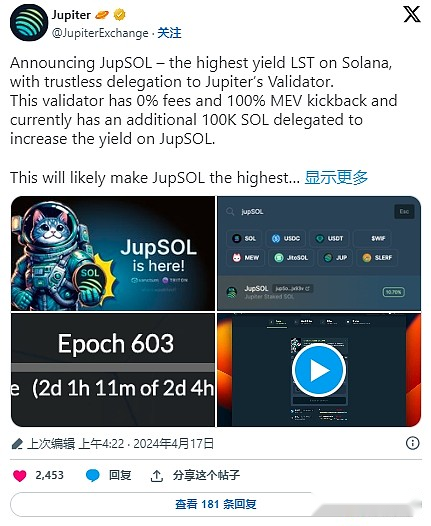
What is Sanctum?
Originally launched in February 2021, Sanctum allows whitelist validators to create and launch their own liquidity staking tokens while unifying the liquidity of these derivatives.
Sanctum’s custom LST can be used for a variety of purposes, from increasing revenue to enabling NFT whitelisting locations or subscription services.Sanctum solves key liquidity staking problems through three core functions, unifying decentralized liquidity and extending limited LST options.Sanctum Router enables seamless LST conversions, and Sanctum Reserve provides instant liquidity to unstake.Sanctum’s Infinity Pool is a multi-LST liquidity pool that natively supports an unlimited number of LSTs, while traditional pools support only a few assets.It ensures fair LST prices and dynamically adjusts swap fees to optimize returns and maintains the correct balance of each LST in the pool.Saving LST or SOL into Infinity Pool can generate Sanctum’s LST and INF, which can be used in DeFi protocols such as Kamino and Meteora.
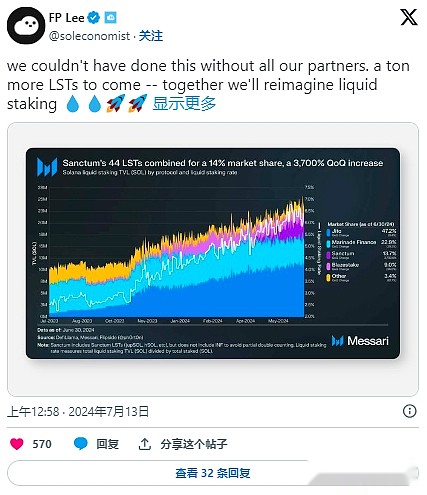
Sanctum’s vision is not limited to liquidity staking.Before the token issuance this Thursday, Sanctum’s FP Lee outlined a vision centered on three core products.
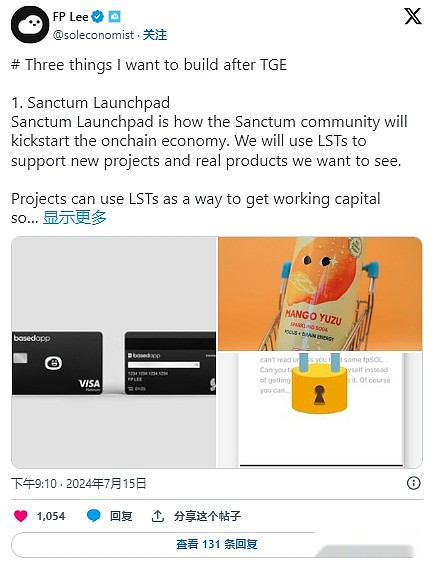
Overall, Sanctum’s approach enhances liquidity, extends LST use cases, and supports the most basic on-chain economy with Launchpad, Profiles V2 and Pay.These developments could have a significant impact on the Solana ecosystem by improving liquidity, creating new LST publishing paths, and providing novel LST use cases.
Re-pled on Solana
In addition to liquid staking, Solana has also seen the continuous evolution of restaking protocols, leveraging the activities of the main chain this cycle to expand its use cases.
Early protocols Cambrian, Picasso, and Solayer were designed to add restaking to Solana’s modular extensions.
Solayer:Restaking provider Solayer aims to create a network of application chains protected by Solana’s economic security.With Solana’s multitasking and fast transaction architecture, Solayer improves workload allocation and service customization.This extends Solana’s capabilities, providing developers with better consensus and block space customization – especially useful given the recent momentum of Solana L2s.Solayer’s May soft start hit the $20 million deposit cap for SOL and LST in 45 minutes, showing strong demand that continued to grow, with its TVL growing to about $127 million.
Cambrian:Cambrian is developing a modular resolution layer for Solana to reduce costs and enhance resource configuration to benefit decentralized oracles and AI processors.Their model allows protocols to rent security from Solana, reducing on-premises solution costs and positioning it as an on-chain alternative to cloud providers such as AWS.Its test network is expected to be launched this summer.
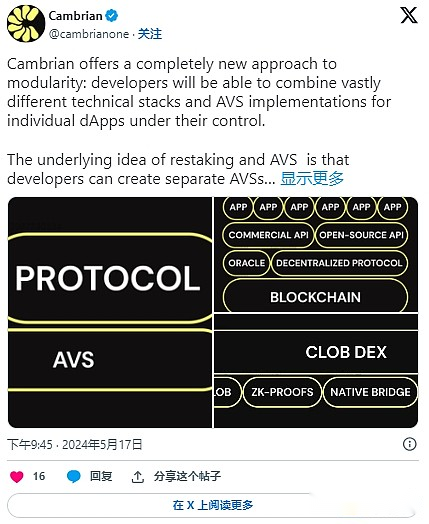
Picasso:Originally focused on connecting Solana and Cosmos, Picasso has evolved into a restaking center that supports other Solana projects such as the upcoming restaking L2 Mantis.Using the Cosmos SDK framework, Picasso connects IBC-enabled chains to enhance its usefulness and security.Picasso’s universal restaking layer and IBC protection require temporary or permanent security applications.This enables SOL and its LST to restake, provide new staking options and facilitate liquidity exchanges.
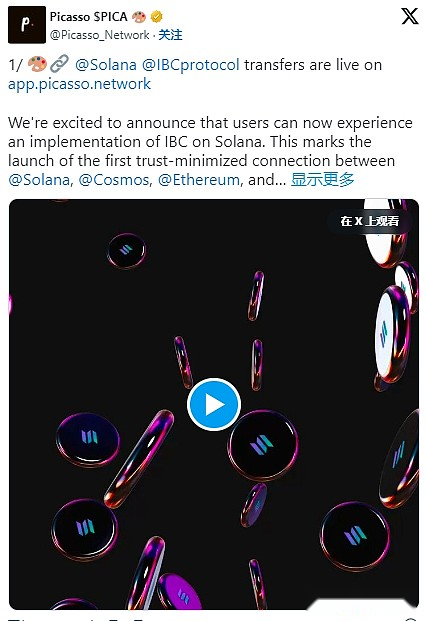
Be prepared for growth
Solana will benefit greatly from the expansion of its pledge economy.
Compared with SOLs that are pledged in LST, the proportion of SOLs pledged in LST is lower. As the ecosystem develops, protocols such as Jito, Marinade Finance and Jupiter will continue to flourish.Sanctum plays a crucial role in this evolution, addressing the problem of liquidity fragmentation.Furthermore, while it may be too early to develop restake on Solana, given the restake status on Ethereum, it does coincide with the modular development momentum we see in SVM L2 and application chains, which meansProtocols such as Cambrian, Solayer and Picasso can extend the main functions of the chain and further drive the growth of LST.
Overall, Solana’s staking economy appears ready to achieve significant growth driven by innovative protocols, competitive yields, and the potential expansion of LST’s on-chain role in developing and supporting the new economy.

